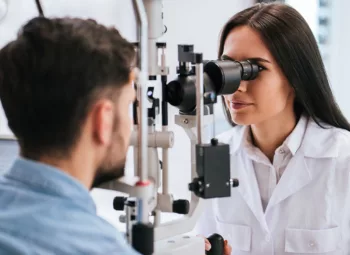Are contact lenses dangerous? Most people believe contact lenses are a risk-free, worry-free option for better vision with less risks than a laser eye surgery like LASIK. However, the truth is that contacts are not without their own risks and can cause serious eye health issues if not used properly.

Risks Associated with Contacts
Keratitis
For contact lens wearers, it’s common innocuous bad habits that put most at risk of infection- things like sleeping in your contacts and wearing your contacts for too long.
The most common infection that can come as a result of wearing contacts for too long is Keratitis. Keratitis is an eye infection that results in the inflammation of the cornea. Symptoms include eye redness, pain, blurred vision, and watery eyes.
Keratitis can typically be treated without any serious complications if promptly attended to, so it is important that you seek the attention of your ophthalmologist if you begin to experience any symptoms. If left untreated, Keratitis could lead to more serious complications like corneal scarring that could permanently affect vision.
Corneal Ulcers
A corneal ulcer is an open sore on the cornea. It is common for contact lens wearers to develop bacterial corneal ulcers from overwearing their contact lenses, especially for those who use extended wear contacts.
Symptoms of corneal ulcers include redness, severe pain, discharge, blurred vision, and a white spot on your cornea. Corneal ulcers a serious issue that should be treated immediately. If left untreated, a corneal ulcer could lead to serious permanent damage for your vision.
Contacts can put users at increased risk for corneal ulcer when lenses scrape the surface of the cornea and make it more susceptible to infection. Bacteria can live and multiply under the surface of your contact lens, especially when contacts are left in and improperly cleaned for long periods of time. These bacteria can multiply and cause corneal ulcers.
Hypoxia and Oxygen Deprivation
A healthy eye depends on a steady flow of oxygen to your cornea. A contact lens, which sits on your cornea, reduces the amount of oxygen which flows through. Hypoxia is a condition which occurs when the cornea does not get enough oxygen and is one of the most common complications of contacts- especially for those who wear them for extended periods of time or forget to remove them when they sleep.
Hypoxia can make the cornea swell and cause temporary hazy vision. Hypoxia over time can cause serious corneal problems. You can reduce the risks of Hypoxia by being mindful of how long you’re wearing your contacts for and by occasionally taking time to not wear contacts throughout your day.
Tips to Reduce Contact Lens Risks
- Practice great hygiene and always wash your hands thoroughly before touching your contacts
- Do not wear your contacts overnight!
- Never use tap water or saliva to clean, lubricate or store your lenses
- Take a break! Take time during the day to let your eyes breathe without your contacts
- Always discard and replace your lenses when directed to by your doctor
- Never ignore the warning signs or symptoms of an infection. If your eyes become red and irritated, remove your contacts and contact your doctor
Are you ready to live life free from the worry or hassle of contacts?
Dr. Shobha Tandon and her staff are here to answer any questions or concerns you may have about taking the next step. Fill out the form below to ask a question or schedule a consultation to learn more about LASIK at NeoVision Eye Center.
"*" indicates required fields





